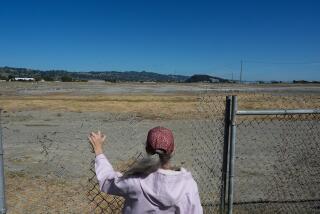Mountain of Mine Waste Poses Dilemma
- Share via
BONNE TERRE, Mo. — There is no ignoring the mountain in the middle of Bonne Terre. It is big--160 feet high, on 32 acres, and it can be seen from any point in town. It is old--it has been there since 1925, when the lead mines piled up sandy waste, or chat, higher and higher.
And it is moving.
Thanks to the prevailing west wind, the pile is creeping east a few inches a year. It has already taken a fairway from the Lead Belt Golf Club and is threatening the parking lot of a mushroom-outlet store.
“If we ignore it long enough,” jokes Joe Layden, managing editor of the Daily Journal, “it will be Ste. Genevieve’s problem.” Ste. Genevieve is 25 miles to the east.
Bonne Terre has grown up around its mountain; the lead mines have come and gone, but the mountain is a permanent feature of the local landscape.
That’s why some of the town’s 3,800 people are upset with Environmental Protection Agency officials who suggest that something must be done because dust blowing off the mountain contains lead, which is known to cause developmental disabilities in children.
“I wish the EPA would move out of town,” said Pearl Burr, 69, whose father and grandfather lived to ripe old ages despite working in the lead mines all of their lives. Her husband, Charlie Burr, 70, a retired lead miner and the son of a lead miner, agreed.
“I feel good,” said Burr, who built a diorama of the interior of the Bonne Terre mine for a local museum.
“If this is the worst problem the government can come up with, then I have to think we are in pretty good shape,” said Pearl Burr. “I don’t know why they feel they have to tear [the chat pile] down. It’s an historic part of our town. It’s part of our identity.”
The chat dump’s western edge borders the playground of the city schools, and a recent study found increased blood-lead levels in some Bonne Terre children between the ages of 6 months and 6 years.
Many residents have serious doubts about the study. They note that the blood-lead levels of nearly all of the Bonne Terre children were within government safety limits and actually much lower than those of children in many urban areas where lead-based paints were used.
Jane Hartrup of the St. Francois County Health Department said blood-lead readings have decreased recently; she attributes the progress mostly to efforts to educate families on diet and hygiene, reducing dust ingestion by children.
The EPA says the dump doesn’t present an immediate health problem but must be dealt with eventually.
But what to do?
At a recent public meeting, the government proposed taking off about the top third of the chat mound, lessening the steepness of the slope and covering it with either dirt and vegetation or rock to keep the chat from blowing or washing away. Almost no one liked that suggestion except Doe Run Co., the successor to the St. Joe Lead Co., which created the chat dump.
“We’re leaning toward flattening it and covering it to stabilize it,” said Doe Run engineer Walter Nowotny.
Doe Run’s position is that since federal law makes it forever responsible for the material, it doesn’t want it spread out over a larger area than it already occupies.
But many townspeople favor moving the dump about a mile to the northwest, using it to fill a natural valley. The site, covered with a layer of topsoil, could then be used for another nine holes on the golf course or for an industrial park.
Some officials fear that, regardless, the chat dump still could be considered a health hazard because it contains a small quantity of lead.
But most people in town don’t believe that.
Using the toe of his shoe to scuff dirt in the street outside one of the oldest homes in town, Layden, the Journal editor, noted that the community had been spreading the chat on icy streets for years.
“I guess it could kill you if you ingested enough of it,” he said. “But I think the cause of death would probably be obstructed bowels. This stuff is like sand.”
More to Read
Sign up for Essential California
The most important California stories and recommendations in your inbox every morning.
You may occasionally receive promotional content from the Los Angeles Times.










